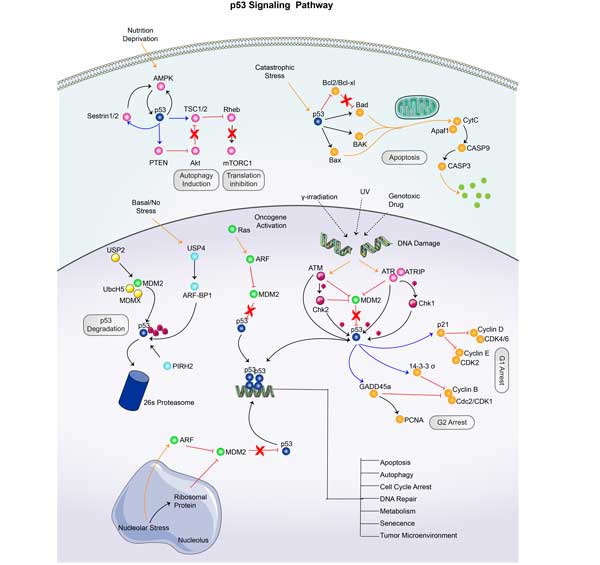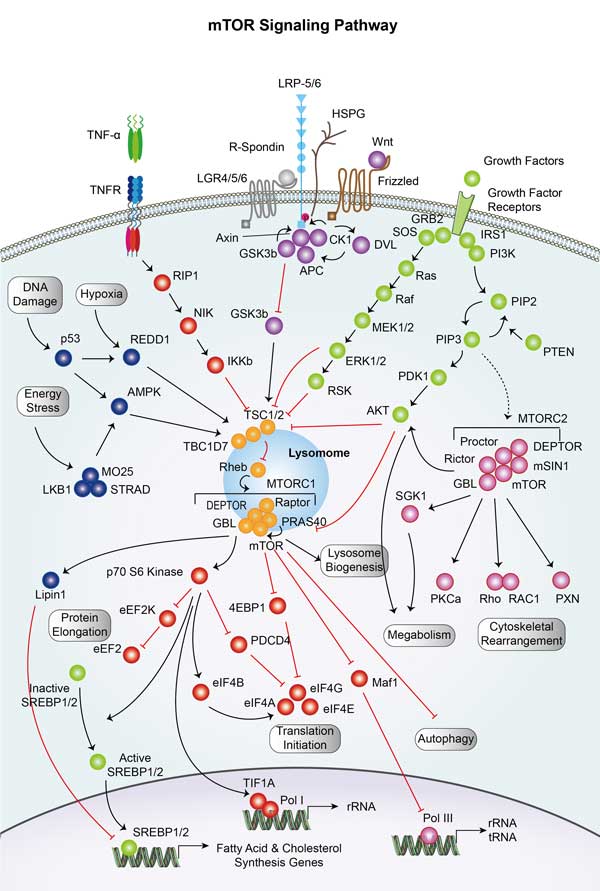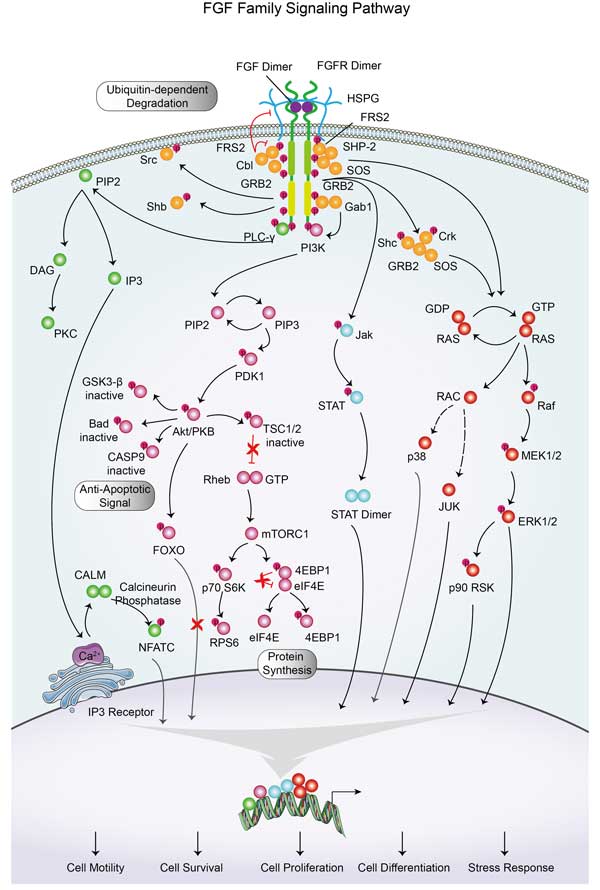RHEB
-
Official Full Name
Ras homolog enriched in brain -
Overview
Rheb (Ras homolog enriched in brain) is an evolutionarily conserved member of the Ras family of small GTP-binding proteins that was originally found to be rapidly induced by synaptic activity in the hippocampus following seizure. While it is expressed at relatively high levels in the brain, Rheb is widely expressed in other tissues and may be induced by growth factor stimulation. Similar to other Ras family members, Rheb triggers activation of the Raf-MEK-MAPK pathway. Biochemical and genetic studies suggest that Rheb plays an important role in regulating the insulin/mTOR signaling pathway. -
Synonyms
RHEB;Ras homolog enriched in brain;Ras homolog enriched in brain 2 , RHEB2;GTP-binding protein Rheb;Ras homolog enriched in brain 2;RHEB2;MGC111559
Recombinant Proteins
- Human
- Rhesus macaque
- Zebrafish
- Rat
- Mouse
- E.coli
- Sf9 Cells
- Mammalian Cells
- Insect Cells
- HEK293
- His
- GST
- T7
- Non
- DDK
- Myc
- Avi
- Fc
Background
What is RHEB protein?
The Ras Homolog Enriched in Brain (RHEB), which has profound implications for cellular growth, neural development, and disease pathology. Since its discovery, RHEB's role and functionality have been the subject of extensive research, providing insights into potential therapeutic applications.
The RHEB protein was first identified and isolated in 1994 during a search for novel Ras-like small GTPases. It was given its name - Ras Homolog Enriched in Brain (RHEB) - because of its structural similarity to the Ras protein and its high expression levels in the brain.
RHEB is a small G-protein spanning approximately 184 amino acids in humans, functioning as a part of the Ras superfamily of proteins. The human RHEB gene is located on the short arm of chromosome 7 at position 36.3. The RHEB protein, like its counterparts in the Ras family, adopts a typical GTPase fold featuring a six-strand beta sheet surrounded by alpha helices. This versatile protein can alternate between the GTP-bound active state and the GDP-bound inactive state, allowing it to function as a cellular switch controlling various cellular processes.
Functions of RHEB Protein
The primary and most well-understood function of the RHEB protein pertains to its role in regulating cell growth and proliferation. RHEB is a potent activator of the mammalian target of rapamycin (mTOR) pathway, a fundamental signaling route involved in cellular processes such as protein synthesis and autophagy. Additionally, RHEB oversees the activation of S6 Kinase and 4E-BP1, proteins responsible for mRNA translation and therefore, increased protein synthesis.
Notably, RHEB also mediates nutrient and energy sensing in cells, managing the cellular metabolism accordingly. It supports cell survival mechanisms under nutrient-depleted conditions through autophagy, a process where cells digest and recycle their components to maintain essential functions.
RHEB Protein-Related Signal Pathway
RHEB dynamically regulates the mTOR Complex 1 (mTORC1) pathway, a critical signaling cascade in the cell. When bound to GTP, RHEB activates mTORC1, promoting cell growth, proliferation, and survival. This activation is dependent on two essential factors: cellular energy levels (monitored via AMPK) and the presence of growth factors or nutrients (controlled by the TSC1/2 complex). Any alterations in these conditions prompt a response from the RHEB protein, effectively altering the engagement of the mTORC1 pathway and controlling cellular activities.
RHEB Protein-Related Diseases
Given RHEB's regulatory role in cellular growth and proliferation, it is unsurprising that its malfunction contributes to pathological conditions, predominantly cancers and neurodegenerative diseases. Over-activation of RHEB, and subsequently mTORC1, is seen in various cancers such as lung, breast, and colorectal. Misregulation of RHEB is instrumental in orchestrating increased cell proliferation, contributing to heightened tumor growth and progression.
In contrast, diminished RHEB expression is linked with neurodegenerative disorders. Low levels of RHEB hinder the mTOR pathway, resulting in decreased neuronal survival and function, characteristic of diseases such as Alzheimer's and Parkinson's.
- Tuberous sclerosis complex (TSC): Caused by mutations in TSC1/TSC2 genes encoding Rheb GAP inhibitor proteins, leading to hyperactivation of mTORC1/Rheb pathway.
- Cancer: Mutations or amplifications of RHEB gene are observed in several cancers like ovarian, brain, breast etc. driving uncontrolled cell growth.
- Autism: Rare mutations in RHEB gene are associated with autism spectrum disorders indicating its role in brain development and function.
- Neurodegeneration: Abnormal RHEB/mTOR signaling implicated in Alzheimer's, Parkinson's and other neurodegenerative diseases.
- Obesity: Dysregulation of RHEB pathway in hypothalamus contributing to increased food intake and weight gain.
- Cancer therapy: RHEB inhibitors/silencing shows promise for treating cancers driven by hyperactive mTORC1 signaling.
- Tuberous sclerosis: RHEB antagonists represent a novel treatment approach for tumors in this genetic disorder.
- Neurodegenerative diseases: Modulating RHEB pathway may benefit conditions like Alzheimer's and Parkinson's.
The understanding of RHEB's functions and relation to various diseases has paved the way for several therapeutic interventions. In cancer, for instance, therapies that modulate RHEB-mTORC1 activity can suppress hyperactive cell proliferation, stifling tumor growth. In contrast, for neurogenerative disorders, therapeutic strategies aim to increase RHEB activity, boosting neuronal survival and function.
Moreover, the RHEB protein has also been implicated in longevity and aging research. Facilitation of the RHEB-mTORC1 pathway promotes cellular survival via autophagy, which can potentially be leveraged to slow down cellular aging.
- Cancer therapy: RHEB inhibitors/silencing shows promise for treating cancers driven by hyperactive mTORC1 signaling.
- Tuberous sclerosis: RHEB antagonists represent a novel treatment approach for tumors in this genetic disorder.
- Neurodegenerative diseases: Modulating RHEB pathway may benefit conditions like Alzheimer's and Parkinson's.
Case Study

(Jeffrey J. Heard, 2018)
Fig2. Western blot showing levels of RHEB, phosphorylated ERK, total ERK and ACTIN in normal and overexpressed-RHEB HEK 293T cell lines. Compare the amount of phosphorylated ERK relative to the total amount of ERK.

(Juan Tan , 2021)
Fig3.Comparison of the expression of RHEB in non-tumor and tumor tissues of the tissue microarray.
Quality Guarantee
High Purity

Fig1. SDS-PAGE (Cat. No.: RHEB-6179H)
Involved Pathway
RHEB involved in several pathways and played different roles in them. We selected most pathways RHEB participated on our site, such as Phospholipase D signaling pathway,mTOR signaling pathway,PIK-Akt signaling pathway, which may be useful for your reference. Also, other proteins which involved in the same pathway with RHEB were listed below. Creative BioMart supplied nearly all the proteins listed, you can search them on our site.
| Pathway Name | Pathway Related Protein |
|---|---|
| Phospholipase D signaling pathway | SHC4,KRAS,PPAP2B,PIP5K1A,SHC2,FYN,PDGFB,PDGFA,PLCB4,PLCB3 |
| PIK-Akt signaling pathway | FGF9,IL2RG,TNXB,MLST8,FGFR2,TNR,PPP2R5D,IL4R,PPP2R5B,GNG2 |
| Thyroid hormone signaling pathway | TSC2,EP300,ATP1B3,FOXO1,ATP2A2,ESR1,PIK3CB,PRKACA,RCAN2,MED17 |
| AMPK signaling pathway | INS,HMGCR,PPARGC1A,RPS6KB2,EIF4EBP1,PPP2R5C,ADIPOR2,PPP2R3A,CPT1C,PPP2R1B |
| Insulin signaling pathway | PPP1CAB,CALM3,AKT3A,PIK3CG,PHKG1B,PYGL,PYGM,PTPRFB,FBP2,PPP1CBL |
| Choline metabolism in cancer | Pdgfa&Pdgfb,SLC44A2,LYPLA1,TAE1,PIK3R1,PRKCG,PLD2,DGKG,FOS,DGKZ |
| mTOR signaling pathway | HIF1A,MAPK3,PIK3R3,PRKCBB,POLDIP3,PTENB,ULK3,RPS6KA1,INS2,PIK3R3B |
Protein Function
RHEB has several biochemical functions, for example, GTP binding,GTPase activity,metal ion binding. Some of the functions are cooperated with other proteins, some of the functions could acted by RHEB itself. We selected most functions RHEB had, and list some proteins which have the same functions with RHEB. You can find most of the proteins on our site.
| Function | Related Protein |
|---|---|
| protein binding | PKN2,FCGR2A,NPLOC4,N6AMT1,ALOX15,AGPAT1,CLNS1A,TAF9,UBA52,CD151 |
| GTP binding | GTPBP3,RND3B,KRAS,RAB33B,RAB26,RAB8A,GIMAP6,ARL1,SEPT7A,EIF2S3 |
| metal ion binding | STK25,USP4,KLF11B,SDF4,ACLYA,SP5,NUBP1,ME3,ZNF562,ZFP280D |
| GTPase activity | TUBA1A,RAP2A,ARF5,EIF5B,RABL2A,RAB42,RRAD,RAB14L,ARHGAP5,IFT22 |
| protein kinase binding | PEBP1,SKAP1,GYS1,SKI,CD3E,CCND3,DCX,MAPK8IP2,NCS1,ACTA2 |
Interacting Protein
RHEB has direct interactions with proteins and molecules. Those interactions were detected by several methods such as yeast two hybrid, co-IP, pull-down and so on. We selected proteins and molecules interacted with RHEB here. Most of them are supplied by our site. Hope this information will be useful for your research of RHEB.
RAF1;EIF1B;MTOR;TRAF2;RPTOR;CREB3;ARIH2;A2M;NCAM1;Traf2;PSEN2;Appl1;Blzf1;ECSIT;pi3p
RHEB Related Signal Pathway
Resources
Related Services
Related Products
References
- Jeon, MT; Nam, JH; et al. In Vivo AAV1 Transduction With hRheb(S16H) Protects Hippocampal Neurons by BDNF Production. MOLECULAR THERAPY 23:445-455(2015).
- Wu, D; Chapman, JR; et al. Intestinal Cell Kinase (ICK) Promotes Activation of mTOR Complex 1 (mTORC1) through Phosphorylation of Raptor Thr-908. JOURNAL OF BIOLOGICAL CHEMISTRY 287:12510-12519(2012).






